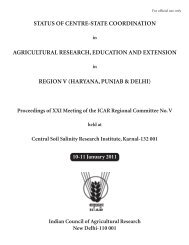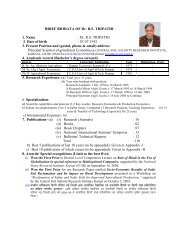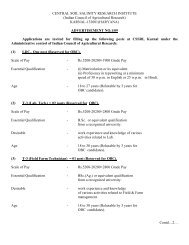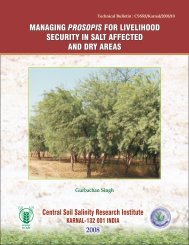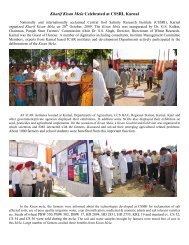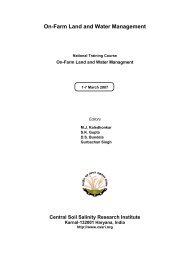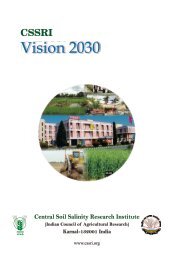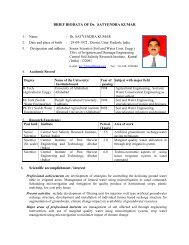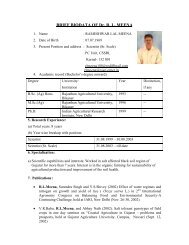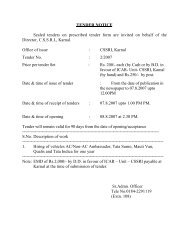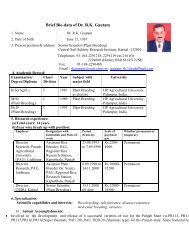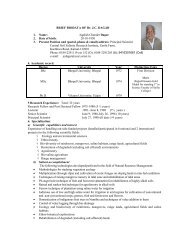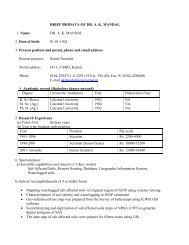BIOSAFOR - BIOSALINE (AGRO) FORESTRY - Central Soil Salinity ...
BIOSAFOR - BIOSALINE (AGRO) FORESTRY - Central Soil Salinity ...
BIOSAFOR - BIOSALINE (AGRO) FORESTRY - Central Soil Salinity ...
Create successful ePaper yourself
Turn your PDF publications into a flip-book with our unique Google optimized e-Paper software.
A test simulation for the suitability of Acacia, Prosopis and Eucalyptus based on the collected tree<br />
requirements from literature was carried out for the Pilot area Haryana state. The number of limiting factors<br />
for the tree growth at the regional scale were discussed and the thresholds refined according to the expert<br />
knowledge in the <strong>BIOSAFOR</strong> consortium.<br />
• A regional biomass production model was developed. All available Salt affected soil (SAS) maps were<br />
updated by University of Hohenheim with additional information provided by CSSRI. The SOTER<br />
database for <strong>BIOSAFOR</strong> was further developed and finalised with the input of some 500 soil profiles. For<br />
the further development of the SOTER structure digital SAS maps were overlaid with the groundwater<br />
depth maps. From the growth parameters biomass accumulation was calculated. Furthermore a mean<br />
annual increase (MAI) of the biomass accumulation was calculated for each tree species. Linear<br />
regressions of the relation between soil ECe and MAI for the most prominent tree species at the Case<br />
Study Areas were established.<br />
For WP 3 a regional biomass production model was developed. All available Salt affected soil (SAS) maps<br />
were updated by University of Hohenheim with additional information provided by CSSRI.<br />
The SOTER database for <strong>BIOSAFOR</strong> was further developed and finalised with the input of some 500 soil<br />
profiles. For the further development of the SOTER structure digital SAS maps were overlaid with the<br />
groundwater depth maps.<br />
The required hydrological data was collected and harmonised at case study scale and at regional scale and a<br />
water resources overview for India, Bangladesh and Pakistan was performed. A GIS was developed with<br />
hydrological and salinity data received from Bangladesh, India and Pakistan. GIS analysis have been carried<br />
out on the locations affected by waterlogging in India pre and post monsoon. GIS analysis was carried out to<br />
find potential areas requiring irrigation in Haryana, India based on climate related factors. For the same area<br />
per unit for groundwater irrigation was estimated.<br />
Recent data on salt affected areas in India has been converted in GIS format, harmonized at the same scale<br />
and projection, and imported into the database. For Bangladesh groundwater salinity data was digitized and<br />
interpolated. Finally Indian state boundaries were updated in the current geo-database of <strong>BIOSAFOR</strong>.<br />
From the growth parameters biomass accumulation was calculated. Furthermore a mean annual increase<br />
(MAI) of the biomass accumulation was calculated for each tree species. The sensitivity of parameters like<br />
soil ECe, pH groundwater depth etc. was tested. Linear regressions of the relation between soil ECe and MAI<br />
for the most prominent tree species at the CSA's were established.<br />
WORK PACKAGE 4<br />
<strong>Salinity</strong> mainly occurs in areas with high evaporation, little precipitation level, high oceanic water tables<br />
and/or irrigated agriculture. Typical areas with salinity problems are river deltas in arid or semi-arid areas,<br />
inland areas with shallow watertables or coastal deserts. Already today salinity is affecting an area<br />
responsible for as much as 10% of all agricultural output and every year the area of salt affected land increases<br />
by 10 million hectares.<br />
Objective of this work package is to characterize and quantify the arid and semi-arid areas affected by salinity<br />
and to assess their (global) biomass production potential.<br />
Conclusions<br />
• Large potentials from slightly and moderately salt-affected areas: 40 and 17 EJ per year<br />
• Small potentials from highly and extremely salt-affected areas: 2 and 3 EJ per year<br />
• Current land use is a limiting factor, but potentials are significant<br />
• Further research: reliability of the yield estimates, accuracy of spatial data, current use of shrub and<br />
herbaceous covered areas, more detailed cost assessments, more species.<br />
23



